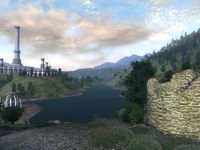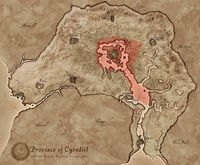| Heartlands | |
|---|---|
| Type | Region |
| Continent | Tamriel |
| Province | Cyrodiil |
| Subregions | City Isle |
| Demonym(s) | Heartlander |
| Appears in | Oblivion, ESO |
The Heartlands (also known as the Valley Heartland)[1] are the central lowlands of Cyrodiil, a grassland region surrounding the expanse of Lake Rumare, as well as the Upper Niben and Niben Bay.[2][3] At its center is the Imperial City, the largest settlement in the province and the seat of Empires, from the original Ayleid Empire[4] to the Cyrodilic Empires of Man.[5]
The Heartlands and the Imperial City are a part of the greater Nibenay region,[6] more specifically the Nibenay Valley that encapsulates the rest of the Niben River and reaches as far south as Blackwood.[3][7] The Heartlands are geographically bordered by the Great Forest from the north, south, and west, the Nibenay Basin to the east, and the central Nibenay Valley around Bravil.[7]
Society and GeographyEdit
DemographicsEdit
The local Imperials are known as Heartlanders, an apt name for this sub-section of Nibenese that live in and around the Imperial City. They are also called Imperial Heartlanders[8] and Nibenean Heartlanders.[9] As is across the Nibenay, there is a hierarchical distinction to be made between the people of the Imperial City and the village-folk outside of it.[3] The villagers live in communities such as Aleswell, Pell's Gate, and Weye. Other lower-class citizens also live in the Waterfront District of the Imperial City, which is outside the outer walls, on Lake Rumare.[2]
A notable Heartlander family is the Carvain family who ruled County Bruma in the late Third Era.[9][10]
Colovians from the west can also be found in the Heartland, however, most of them come from the Imperial Legion military,[11]:158 who are headquartered in the Imperial City Prison.[12]
The Imperial City, as the epicenter of the Empire, is cosmopolitan in nature. Upon his ascension to the throne, Reman I incorporated aspects of the Nibenay, Colovia, High Rock, and the recently defeated Akaviri to turn the Imperial City and his Empire of Man into a worldly center of civilization.[5] This even extended to the Third Empire, which came much later. In its early years, Redguards were seldom seen, at least compared to the Bretons, Dunmer, and Nords. In a biographical note written in the Notes for Redguard History, the famous author of Redguard history and verse, Destri Melarg had to adopt his surname to fit in with these other cultures.[14] In at least the first half of the Second Era, there was also a small, yet notable community of Bosmer in the Waterfront District.[15]
Before it was taken over by the Imperials, the White-Gold Tower was the seat of the Ayleid Empire, a vast nation across modern-day Cyrodiil that comprised of the eponymous Ayleids, also known as the Heartland High Elves.[16][17] The enchanters of this period were considered some of the most clever and prodigal in the craft.[18] With the White-Gold Tower's establishment, trade flourished in central Cyrodiil and especially south in the Niben Bay, where it became one of the Ayleid Empire's most active and secure regions.[19][20] Up north in the Heartlands, several city-states sprung up around it, whether it was around Lake Rumare like Fanacasecul, or further out like Belda more inland and Culotte on the Upper Niben.[2]
Ayleid Lore[21]
Some of them hold dark, ancient secrets and history, like Sercen's "gut-gardens"[16] and Nagastani, which supposedly held some kind of evil power that has left the land around it dead.[22] Perhaps the most infamous city-state was Abagarlas, a former city of mercenaries and center of worship for Molag Bal. Its ancient history is tied to a rival city of Meridia known as Delodiil, which was also located in the Heartlands. But while Abagarlas' ruins remain underneath City Isle, Delodiil's location and ruins are completely lost to time.[23]
Modern translations of what remains of the Unhendra Nibenu, a Merethic Era epic of Topal the Pilot's explorations indicate that before the Ayleids lived in the Heartlands, there was a race of Bird beastfolk that has since gone extinct. The fourth fragment of the Unhendra Nibenu remains as one of the only sources of their existence. The Third Era scholar who translated it, Florin Jaliil believed that their extinction came from an encounter with the "cat demons" mentioned early in the text.[19]
Culture and IndustryEdit
Culturally, this region is distinguished from other places like County Bruma as the Heartland Empire.[24]
- Farming (Rice[3]/)/Fishing
- Gondolas/Ferries[3]
- Akaviri Inspiration[3]
- Red Ring Road
- Cults[13]
- Shezarr[3][25]
- Mages Guild/Arcane University[26]
- Imperial Legion[12][27]
- Imperial Sewers
EcosystemEdit
The Heartlands, as well as the Nibenay Valley, are considered the agricultural breadbaskets of Cyrodiil.[28]
- City Isle/Eight Islands[19]
- Sacred Lotus/Water Hyacinth/Nirnroot/Fly Amanita/Lavender/Morning Glory
- Brindle Badger/Heartland Butcher's Dog/River Crab/Shezarr's Chicken
- Rumare Slaughterfish/Lake Fish (Runmare Bream/Rainbow Fish/Yellow Perch)/Foul Fish (Sewer Eel/Pufferfish/Quillfish)
The Subtropical HeartlandsEdit
HistoryEdit
The Pre-Imperial HeartlandsEdit
It is generally understood that before man and mer lived on Tamriel, the beastfolk were the sole inhabitants of the continent.[31] In the Heartlands, it was occupied by an ancient race of birdmen whose legacy remains in oral histories and the fragmented ballad of Topal the Pilot, the Unhendra Nibenu.[5][19] A translation of these fragments and notes provided by Florin Jaliil, gives us a look into Topal's journey in the Middle Merethic Era.[19]
As the Niben sailed along the eastern continental seaboard, trying to find their way back to Firsthold, they come across the Topal Bay and at the behest of his crew, traveled north through the Niben River. En route, they witnessed "cat demons" and in eleven days time, they reached Lake Rumare and the Eight Islands in its center. Topal became enchanted by the beauty of the islands and the birdfolk that lived there. He taught them how to read and write, and in gratitude, they named him their lord and offered him the islands as a gift,[19] though some people suggest it was a transaction.[32] Topal made a promise that he would return one day,[19] and while the story of his return remains a mystery, the elves of the distant Summerset Isles did eventually return.[4]
The Heartlands, at that time, was purportedly a tribute land to the High King of Alinor. In time, the original Ayleids came to populate the Heartlands.
Early HistoryEdit
The Heartlands in the Second EmpireEdit
- Reman I[38]/Expansion South[27]
- Akaviri{{Ref|name=TTS|The Tonenaka Shrine — Magnate Feina-Darak[3]
The Heartlands in the InterregnumEdit
The Heartlands in the Third EmpireEdit
Though Cyrodiil experienced relative peace throughout the early Third Era, the Heartlands and the Imperial City have had moments of weakness.[5] The first year of the War of the Red Diamond was one such example. As conflict arose in northern Tamriel, Empress Kintyra II led an army to the Iliac Bay, leaving the Imperial City short on defenses. With the Elder Council completely occupied and the rest of the Imperial Army sent off as well, Prince Uriel Mantiarco of Solitude invaded the ill-defended city and proclaimed himself Emperor Uriel Septim III, while his cousin Kintyra II was imprisoned.[43][44] Years later in 3E 127, King Cephorus of Gilane marched into the Imperial City after Uriel III's death and named himself Emperor as Cephorus Septim I.[45][46]
- Oblivion Crisis
Post-Oblivion CrisisEdit
- Stormcrown Interregnum/Titus Mede I
- Umbriel
- Great War
Notable LocationsEdit
- Abagarlas
- A former Ayleid city on the northeast side of City Isle. It was once a place of worship for Molag Bal
- Aleswell
- A farming town on the northwest corner of the region
- Imperial City
- Lake Rumare
- Niben Bay
- Pell's Gate
- A town near the southern coast of Lake Rumare. It is right next to the start of the Green Road
- Red Ring Road
- A major road that surrounds Lake Rumare and branches out across the province
- Vanua
- An Ayleid ruin where Pelinal Whitestrake famously made his last stand
- Vilverin
- A former Ayleid city on the northeast coast of Lake Rumare. Its clans escaped southwest into Valenwood
- Weye
- A town across from the Imperial City's bridge
GalleryEdit
See AlsoEdit
- For game-specific information, see the Oblivion and Elder Scrolls Online articles.
BooksEdit
ReferencesEdit
- ^ a b Varieties of Faith... — Brother Mikhael Karkuxor of the Imperial College
- ^ a b c Heartlands in Oblivion
- ^ a b c d e f g h i Pocket Guide to the Empire, 1st Edition: Cyrodiil — Imperial Geographical Society, 2E 864
- ^ a b c Before the Ages of Man — Aicantar of Shimerene
- ^ a b c d Pocket Guide to the Empire, 3rd Edition: The Seat of Sundered Kings: Cyrodiil — Imperial Geographical Society, 3E 432
- ^ Loading Screen text in Oblivion
- ^ a b Map of Cyrodiil – The Elder Scrolls IV: Oblivion
- ^ Humilis Nonius' dialogue in Oblivion
- ^ a b Guide to Bruma — Alessia Ottus
- ^ An Explorer's Guide to Skyrim — Marcius Carvain, Viscount Bruma
- ^ The Infernal City — Greg Keyes
- ^ a b Imperial City Prison loading screen text in ESO: Imperial City
- ^ a b Reflections on Cult Worship — Cuseius Plecia
- ^ Notes For Redguard History — Destri Melarg
- ^ Crafting Motif 3: Wood Elf Style — Doctor Alfidia Lupus
- ^ a b c The Adabal-a — Morihaus
- ^ The Amulet of Kings — Wenengrus Monhona
- ^ Curiosities of the Second Age
- ^ a b c d e f g Father Of The Niben — Florin Jaliil
- ^ Daughter of the Niben — Sathyr Longleat
- ^ a b Umbacano's dialogue in Oblivion
- ^ Letter to Alma — Dreadlord Naucratius
- ^ a b The Whithering of Delodiil — Unknown
- ^ Suurootan's dialogue in Oblivion
- ^ Shezarr and the Divines — Faustillus Junius
- ^ Raminus Polus' dialogue in Oblivion
- ^ a b The Restoration of Fort Grief — Devastator Idrian Volturno, Spring, 2E 580
- ^ Generic Dialogue in Oblivion
- ^ The Heartlands of Cyrodiil
- ^ Subtropical Cyrodiil: A Speculation — Lady Cinnabar of Taneth
- ^ Pocket Guide to the Empire, 3rd Edition: All the Eras of Man, A Comprehensive History of our History — Imperial Geographical Society, 3E 432
- ^ Decentius Opsius' dialogue in Oblivion
- ^ Daedra Worship: The Ayleids — Phrastus of Elinhir
- ^ PGE
- ^ Ayleid Cities of Valenwood — the Esteemed Historian Homfrey at the University of Gwylim, 2E 455
- ^ a b Aurbic Enigma 4: The Elden Tree — Beredalmo the Signifier
- ^ Ayleid Survivals in Valenwood — Cuinur of Cloudrest, 4th Tier Scholar of Tamrielic Minutiae
- ^ a b Remanada
- ^ On the War of Righteousness
- ^ Eulogy for Emperor Varen — Lord Abnur Tharn, Chancellor of the Elder Council
- ^ Meet the Character - Tribune Alea — Commander Merian
- ^ The Arcturian Heresy — The Underking, Ysmir Kingmaker
- ^ Brief History of the Empire v 1 — Stronach k'Thojj III
- ^ The Wolf Queen, v7 — Waughin Jarth
- ^ Brief History of the Empire v 2 — Stronach k'Thojj III
- ^ The Wolf Queen, v8 — Waughin Jarth
Note: The following references are considered to be unofficial sources. They are included to round off this article and may not be authoritative or conclusive.

